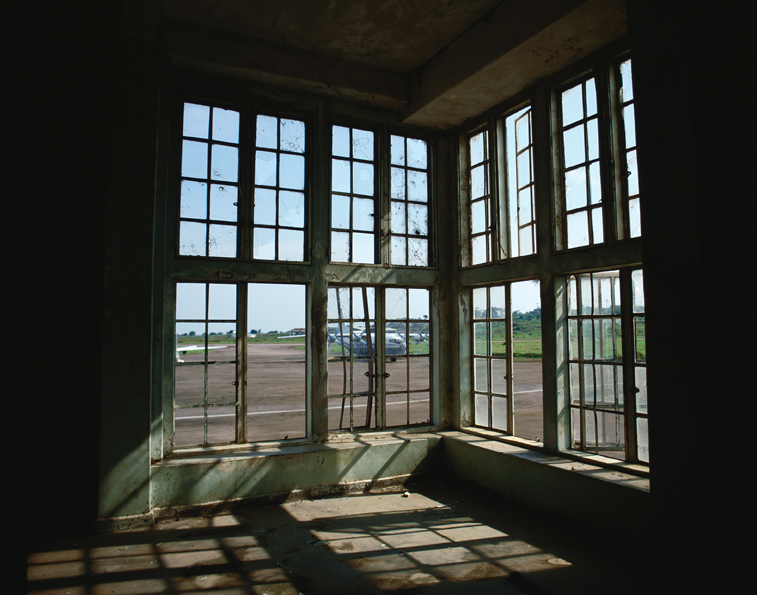
© » KADIST
Jeff Burton
In Eniko Mihalik (2012), the camera captures a glimpse of the eponymous Hungarian model as seen through a rearview mirror. They are both two examples of the artist’s many enigmatic photographs of models, actors, musicians, and other powerful figures rooted in the celebrity-driven culture of Los Angeles. Catching a glimpse of the model, the viewer enters into the world of the celebrity.

© » KADIST
Matthew Buckingham
Matthew Buckingham presents a narrative directly connected with a highly symbolic site in the United States, the Mount Rushmore Memorial*. He elaborates a historiographic narrative of this place and switches it into the domain of science fiction by proposing a photograph of the Memorial as it should appear in 500 000 years. The effigies of Washington, Jefferson, Lincoln and Roosevelt become unrecognizable.

© » KADIST
Jeff Burton
Negligee (2013) serves as an example of this tension, with its artful angle and play with shadow and light upon the sensual subject, rendering the image ambiguous. Like much of Burton’s work, Negligee reflects both his experience as a commercial photographer and his interest in the voyeurism, desire, vulnerability, and power of the photographic act.

© » KADIST
Collier Schorr
Collier Schorr’s prints upend conventions of portrait photography by challenging what it means to “document” a subject. American Flag (Scratch) (1999), for example, depicts an unidentified male subject clad in an American flag-print singlet. With his head and extremities out of frame, the camera focuses on his flush-red torso, his left nipple protruding from the singlet’s strap.

© » KADIST
Zarina Bhimji
Born in Uganda of Indian descent, Bhimji has lived in London after her family sought refuge from the regime of Idi Amin who compulsorily expelled all Asians from Uganda. Her recent work has been concerned with revisiting the country of her childhood and engaging with the experience of exile, political and social destruction, and deprivation. This photograph, which belongs to the series “Love”, was shot by Bhimji during her journey in Uganda in 2001, but was only edited in 2006.

© » KADIST
Collier Schorr
In the Collage II (Marie) (2013), Shorr seems to have an ostensibly clear subject, a female subject identified in the work’s title as “Marie,” a slim but athletic woman with brown hair pictured reclining atop a brilliantly white sheet draped against a marbled tan-and-white backdrop. Although photographed topless, Marie is depicted in slightly contorted poses that emphasize the curves of her figure while also obstructing the viewer’s gaze. Printed on high gloss paper, Marie’s portrait has the polished veneer of magazine spread, and the two portraits on display offer different vantages of the same subject.

© » KADIST
Michael Landy
H.2. N. Y Skeleton of the Dump revolves entirely around the performance “Homage to New York” (1960), of the Swiss artist Jean Tinguely (1925-1991), during which the machine built by the artist in the gardens of the Museum of Modern Art (MOMA) had to self-destruct itself in 27 minutes, but, in the end, it had to be finished off by firemenbeing called in after it erupted in flames. Since the discovery of Jean tinguely’s retrospective at the Tate Gallery in London, in 1982, Michael Landy spent two years researching and sketching (charcoal, oil, glue, ink) from his previous research carried out at Museum Tinguely in Basel, and at the MOMA in New York.
Jeff Burton
- location: Los Angeles, California
- year born: 1963
- gender: male
- nationality: American
- home town: Anaheim, California
Zarina Bhimji
- location: Mbarara, Uganda
- year born: 1963
- gender: female
- nationality: Ugandan
Michael Landy
- location: London, United Kingdom
- year born: 1963
- gender: male
- nationality: British
Matthew Buckingham
- location: Nevada, United States
- year born: 1963
- gender: male
- nationality: American
-
1990-1999
Collier Schorr
1999Collier Schorr’s prints upend conventions of portrait photography by challenging what it means to “document” a subject...
-
2000-2009
Zarina Bhimji
2001Born in Uganda of Indian descent, Bhimji has lived in London after her family sought refuge from the regime of Idi Amin who compulsorily expelled all Asians from Uganda...
Matthew Buckingham
2002Matthew Buckingham presents a narrative directly connected with a highly symbolic site in the United States, the Mount Rushmore Memorial*...
-
2010-2019
Jeff Burton
2012In Eniko Mihalik (2012), the camera captures a glimpse of the eponymous Hungarian model as seen through a rearview mirror...
Jeff Burton
2013Negligee (2013) serves as an example of this tension, with its artful angle and play with shadow and light upon the sensual subject, rendering the image ambiguous...
Collier Schorr
2013In the Collage II (Marie) (2013), Shorr seems to have an ostensibly clear subject, a female subject identified in the work’s title as “Marie,” a slim but athletic woman with brown hair pictured reclining atop a brilliantly white sheet draped against a marbled tan-and-white backdrop...